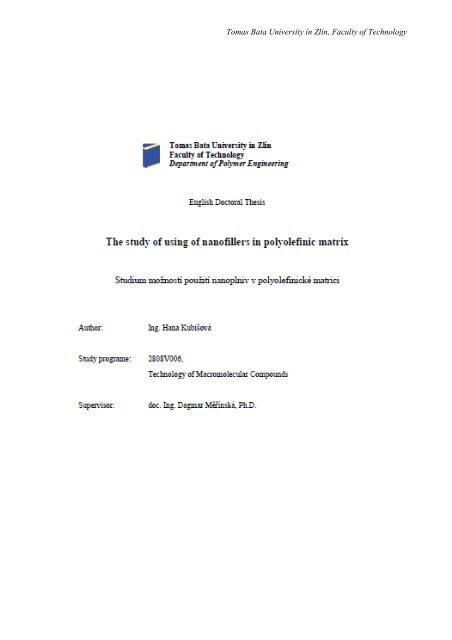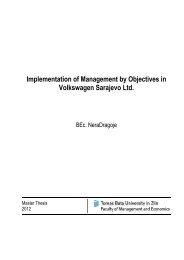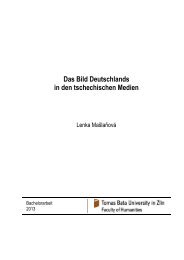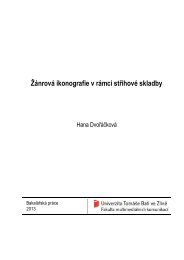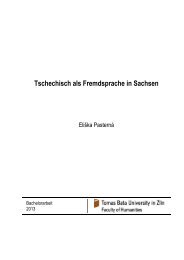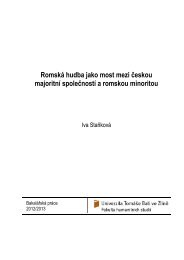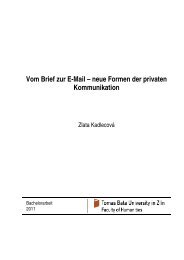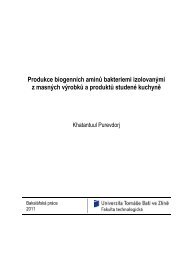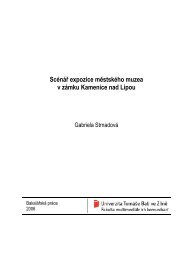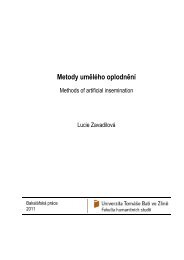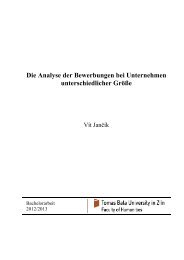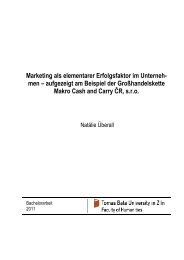The study of using of nanofillers in polyolefinic matrix - DSpace UTB
The study of using of nanofillers in polyolefinic matrix - DSpace UTB
The study of using of nanofillers in polyolefinic matrix - DSpace UTB
Create successful ePaper yourself
Turn your PDF publications into a flip-book with our unique Google optimized e-Paper software.
Tomas Bata University <strong>in</strong> Zlín, Faculty <strong>of</strong> Technology<br />
OUTLINE<br />
~ 3 ~
Tomas Bata University <strong>in</strong> Zlín, Faculty <strong>of</strong> Technology<br />
~ 4 ~
OUTLINE<br />
Tomas Bata University <strong>in</strong> Zlín, Faculty <strong>of</strong> Technology<br />
ABSTRACT ............................................................................................................................................ 6<br />
ABSTRAKT ............................................................................................................................................ 7<br />
1. INTRODUCTION ......................................................................................................................... 8<br />
2. POLYMER MATRIX ................................................................................................................... 9<br />
2.1. POLYETHYLENE .................................................................................................................... 9<br />
2.2. POLYPROPYLENE ............................................................................................................... 10<br />
3. CLAY MINERALS ..................................................................................................................... 12<br />
3.1. PHYLOSILICATES ............................................................................................................... 12<br />
3.2. MONTMORILLONITE ......................................................................................................... 13<br />
4. CALCIUM CARBONATE ......................................................................................................... 15<br />
5. COMPOUNDING ....................................................................................................................... 16<br />
6. AIMS OF WORK ........................................................................................................................ 18<br />
SUMMARY OF ARTICLES ................................................................................................................ 23<br />
ARTICLE I. ........................................................................................................................................... 28<br />
ARTICLE II. ......................................................................................................................................... 32<br />
ARTICLE III. ........................................................................................................................................ 50<br />
ARTICLE IV. ........................................................................................................................................ 60<br />
CONCLUSIONS.................................................................................................................................. 66<br />
7. PUBLICATIONS ........................................................................................................................ 67<br />
8. CURRICULUM VITAE ............................................................................................................. 69<br />
~ 5 ~
ABSTRACT<br />
Tomas Bata University <strong>in</strong> Zlín, Faculty <strong>of</strong> Technology<br />
PhD thesis was focus on problematic <strong>of</strong> polyolef<strong>in</strong>e/clay nanocomposites – preparation <strong>of</strong><br />
(nano) composites and properties <strong>of</strong> prepared nanocomposites. Two polymer <strong>matrix</strong>es<br />
were used for <strong>study</strong>. Different types <strong>of</strong> (nano) fillers were used. (Nano) composites were<br />
prepared at different conditions (time <strong>of</strong> compound<strong>in</strong>g, speed <strong>of</strong> rotations). Changes <strong>of</strong><br />
mechanical and barrier properties were <strong>study</strong>. Influence <strong>of</strong> conditions to properties was<br />
<strong>study</strong> too.<br />
First part <strong>of</strong> research is focus on barrier properties <strong>of</strong> PE and PP nanocomposites. Second<br />
part was focus on use <strong>of</strong> nan<strong>of</strong>iller <strong>in</strong> PP <strong>matrix</strong>, the follow<strong>in</strong>g research is focused on<br />
<strong>study</strong> <strong>of</strong> <strong>in</strong>fluence <strong>of</strong> conditions <strong>of</strong> preparation to mechanical properties <strong>of</strong> (nano)<br />
composites, and application <strong>of</strong> mathematic model for evaluation <strong>of</strong> mechanical properties.<br />
It was obta<strong>in</strong>ed that polypropylene/clay nanocomposites had better barrier properties than<br />
polyethylene/clay nanocomposites. <strong>The</strong> follow<strong>in</strong>g <strong>study</strong> shows that all prepared (nano)<br />
composites have higher mechanical properties <strong>in</strong> comparison with unfilled polymer<br />
<strong>matrix</strong>. <strong>The</strong> optimal condition <strong>of</strong> preparation was determ<strong>in</strong>ed by <strong>us<strong>in</strong>g</strong> <strong>of</strong> 3D graph. New<br />
mathematic model which was used for description <strong>of</strong> mechanical properties very good<br />
describes measured data.<br />
KEY WODRS<br />
nanocomposite, mechanical properties, barrier properties, mathematic model<br />
~ 6 ~
ABSTRAKT<br />
Tomas Bata University <strong>in</strong> Zlín, Faculty <strong>of</strong> Technology<br />
Doktorská práce byla zaměřena na problematiku polyolef<strong>in</strong>/jíl nanokompozity – přípravu<br />
(nano) kompozitů a vlastnosti připravených nanokompozitů. Dvě polymerní matrice byly<br />
použity pro přípravu. Různé typy (nano) plniva byly použity. (Nano) kompozity byly<br />
připraveny při rozdílných podmínkách přípravy (doba míchání, rychlost míchání). Změny<br />
mechanických a bariérových vlastností byly studovány. Vliv podmínek přípravy na<br />
vlastnosti (nano) kompozitů byl studován taktéž.<br />
První část výzkumu se zaměřuje na bariérové vlastnosti PE a PP nanokompozitů. Druhá<br />
část se zaměřuje na použití rozdílných druhů nanoplniva v PP matrici, následující výzkum<br />
se zaměřuje na studium vlivu podmínek přípravy na mechanické vlastnosti (nano)<br />
kompozitů a využití matematického modelu pro hodnocení mechanických vlastností.<br />
Bylo zjištěno, že polypropylen/jíl nanokompozity měli lepší bariérové vlastnosti než<br />
polyetylen/jíl nanokompozity. Následující studie ukázala, že všechny připraveny (nano)<br />
kompozity měly vyšší mechanické vlastnosti než neplněná polymerní matrice. Optimální<br />
podmínky přípravy byly určeny pomocí 3D grafů. Nový matematický model, který byl<br />
použitý pro hodnocení mechanických vlastností, velmi dobře popisuje naměřené hodnoty.<br />
KLÍČOVÁ SLOVA<br />
nanokompozity, mechanické vlastnosti, bariérové vlastnosti, matematický model<br />
~ 7 ~
1. INTRODUCTION<br />
Tomas Bata University <strong>in</strong> Zlín, Faculty <strong>of</strong> Technology<br />
Nanocomposites are materials which <strong>study</strong> had been started <strong>in</strong> 90 th years <strong>of</strong> last century. <strong>The</strong><br />
reasons <strong>of</strong> <strong>study</strong> <strong>of</strong> nanocomposites are their unique properties <strong>in</strong> comparison with a pure<br />
polymer <strong>matrix</strong>.<br />
Nanocomposites are composed <strong>of</strong> polymer <strong>matrix</strong> and nan<strong>of</strong>iller. Polymer <strong>matrix</strong> can be<br />
based on polypropylene, polyethylene, polyamide, polystyrene [1-8]. Montmorillonite,<br />
saponite, bentonnite are clay m<strong>in</strong>erals which are used like nan<strong>of</strong>illers [7, 9-17].<br />
Studies showed that the use <strong>of</strong> small concentration <strong>of</strong> nan<strong>of</strong>iller improved mechanical<br />
properties, flammability or gas permeability [18-24].<br />
<strong>The</strong> process <strong>of</strong> preparation is very complicated. <strong>The</strong> complication <strong>of</strong> preparation is caused by<br />
different properties <strong>of</strong> polymer <strong>matrix</strong> and nan<strong>of</strong>iller. This PhD work was focused to the<br />
problematic <strong>of</strong> preparation <strong>of</strong> nanocomposites and <strong>in</strong>fluence <strong>of</strong> condition <strong>of</strong> preparation to the<br />
f<strong>in</strong>al properties <strong>of</strong> nanocomposites.<br />
Different types <strong>of</strong> nan<strong>of</strong>illers and fillers were used for preparation <strong>of</strong> (nano)composites. <strong>The</strong><br />
conditions <strong>of</strong> preparation were different too. All prepared (nano)composites were <strong>study</strong> from<br />
morphological view and also from mechanical properties too. Mathematic model was used for<br />
characterization <strong>of</strong> prepared nanocomposites.<br />
Gas permeability was <strong>study</strong> due to <strong>of</strong> theory that conta<strong>in</strong> <strong>of</strong> nan<strong>of</strong>iller causes decrease <strong>of</strong> gas<br />
permeability. Lower gas permeability is very necessary <strong>in</strong> food packag<strong>in</strong>g.<br />
~ 8 ~
2. POLYMER MATRIX<br />
Tomas Bata University <strong>in</strong> Zlín, Faculty <strong>of</strong> Technology<br />
Polymer <strong>matrix</strong> is one <strong>of</strong> part <strong>of</strong> nanocomposites. In our <strong>study</strong> both type <strong>of</strong> polymer <strong>matrix</strong>es<br />
were used: polyethylene and polypropylene. This chapter describes properties, use and<br />
technology <strong>of</strong> use polymer materials.<br />
Polyolef<strong>in</strong>ic materials (polyethylene and polypropylene) were used <strong>in</strong> our work. Polyolef<strong>in</strong>ic<br />
are materials which conta<strong>in</strong>ed double bond <strong>in</strong> polymeric cha<strong>in</strong>s. Homopolymers and<br />
copolymer <strong>of</strong> polyethylene are the most important types <strong>of</strong> polyolef<strong>in</strong>s.<br />
2.1. POLYETHYLENE<br />
Polyethylene (PE) is called homopolymer <strong>of</strong> ethylene and their copolymers which conta<strong>in</strong> less<br />
than 10 wt. % <strong>of</strong> co-monomer. <strong>The</strong> properties <strong>of</strong> polyethylene are based on molecular weight,<br />
spatial <strong>of</strong> monomer <strong>in</strong> cha<strong>in</strong> <strong>of</strong> macromolecule and degree <strong>of</strong> crystall<strong>in</strong>ity. All <strong>in</strong>itiate<br />
properties are depended on preparation <strong>of</strong> PE.<br />
<strong>The</strong> first polyethylene was prepared <strong>in</strong> 1935. <strong>The</strong> polyethylene was prepared under pressure<br />
100-400 MPa at the temperature 150-300°C. A small concentration <strong>of</strong> oxide was used as<br />
<strong>in</strong>itiator.<br />
<strong>The</strong> preparation <strong>of</strong> PE was modified. Today, PE is prepared by suspension, emulsion<br />
polymerization. <strong>The</strong> products have an average molecular weight between 15 000 and 40 000,<br />
melt<strong>in</strong>g temperature from 105°C to 120°C and the cha<strong>in</strong>s <strong>of</strong> macromolecular are branched.<br />
Classification <strong>of</strong> polymer can be from follow<strong>in</strong>g perspectives: structure, density and<br />
preparation. [25-26]<br />
Polyethylene is classified from the structure to:<br />
� l<strong>in</strong>ear polyethylene,<br />
� branched polyethylene.<br />
~ 9 ~
Classification <strong>of</strong> polyethylene based on density:<br />
� low density polyethylene (LD-PE),<br />
� high density polyethylene (HD-PE),<br />
� ultra high molecular weight (UHMW-PE),<br />
� l<strong>in</strong>ear low density polyethylene (LLD-PE),<br />
� medium density polyethylene (MD-PE).<br />
Tomas Bata University <strong>in</strong> Zlín, Faculty <strong>of</strong> Technology<br />
<strong>The</strong> last classification is from the view <strong>of</strong> a preparation. <strong>The</strong>se types are high-pressure<br />
polyethylene and low-pressure polyethylene.<br />
<strong>The</strong> chemical resistance is based on degree <strong>of</strong> crystall<strong>in</strong>ity (higher degree <strong>of</strong> crystall<strong>in</strong>ity<br />
causes higher resistance <strong>of</strong> PE). Polyethylene is resistant to water, non oxide chemicals at<br />
normal temperature. However, the resistance to non polar solvents is depended on<br />
temperature. [25-26]<br />
Polyethylene is white and transparent at normal temperature. <strong>The</strong> transparency <strong>in</strong>creases <strong>in</strong><br />
degree <strong>of</strong> branch <strong>of</strong> macromolecules an theirs molecular weight.<br />
Polyethylene is processed by <strong>in</strong>jection mould<strong>in</strong>g and extrusion. Application <strong>of</strong> PE is very<br />
various: PE materials are used for preparation <strong>of</strong> packag<strong>in</strong>g, house wares. PE is used <strong>in</strong><br />
medical science too. [25-26]<br />
2.2. POLYPROPYLENE<br />
Polypropylene (PP) is prepared by radical or cationic polymerization <strong>of</strong> propylene. This type<br />
<strong>of</strong> polypropylene is low molecular ataxic product. Guilio Natta discovered that the presence<br />
~ 10 ~
Tomas Bata University <strong>in</strong> Zlín, Faculty <strong>of</strong> Technology<br />
<strong>of</strong> Ziegler catalyst caused the preparation <strong>of</strong> high molecular polypropylene which is very<br />
crystall<strong>in</strong>e isotactic polypropylene. [27-29]<br />
<strong>The</strong> structure <strong>of</strong> polypropylene is non polar. <strong>The</strong> degree <strong>of</strong> crystall<strong>in</strong>ity <strong>of</strong> polypropylene is<br />
from 60 % to 75 %. This fact causes that polypropylene is non transparent polymeric material<br />
<strong>in</strong> comparison with polyethylene. Melt<strong>in</strong>g temperature <strong>of</strong> isotactic polypropylene is 176°C;<br />
however, the commercial products have the melt<strong>in</strong>g temperature from 160°C to 170°C.<br />
Today, polypropylene is produce to low-pressure polymerization. [27-29]<br />
<strong>The</strong> properties <strong>of</strong> polypropylene are different <strong>in</strong> comparison with polyethylene. <strong>The</strong> follow<strong>in</strong>g<br />
properties - density <strong>of</strong> polypropylene, cold-resistant, oxidation resistant, weather-resistant, are<br />
lower than polyethylene. On the other hand, strength, hardness and abrasionpro<strong>of</strong> are higher<br />
<strong>in</strong> comparison with PE. [27-29]<br />
Polyethylene is processed by <strong>in</strong>jection mould<strong>in</strong>g and extrusion. Low gas permeability and<br />
moisture vapour transmission are the reason <strong>of</strong> application <strong>of</strong> polypropylene as packag<strong>in</strong>g<br />
materials. Components <strong>of</strong> mach<strong>in</strong>e, automotive, consumer <strong>in</strong>dustry are the other areas <strong>of</strong><br />
application <strong>of</strong> polypropylene. <strong>The</strong> next application <strong>of</strong> polypropylene is preparation <strong>of</strong> fibers.<br />
<strong>The</strong> prerequisite is that the <strong>in</strong>dex <strong>of</strong> isotactic is higher than 90 %. [27-29]<br />
~ 11 ~
3. CLAY MINERALS<br />
Tomas Bata University <strong>in</strong> Zlín, Faculty <strong>of</strong> Technology<br />
Clay m<strong>in</strong>erals are group <strong>of</strong> m<strong>in</strong>erals which are used for preparation <strong>of</strong> nan<strong>of</strong>iller. <strong>The</strong><br />
def<strong>in</strong>ition <strong>of</strong> clay is follow<strong>in</strong>g: clays are mixed nature material which is primary compound<br />
from f<strong>in</strong>eness <strong>of</strong> gra<strong>in</strong> m<strong>in</strong>erals. Generally, clay is plastic at adequate conta<strong>in</strong> <strong>of</strong> water. Clays<br />
<strong>in</strong>durate by dried or calc<strong>in</strong>ation. This def<strong>in</strong>ition was def<strong>in</strong>ed by Guggenheima and Mart<strong>in</strong>a<br />
from 1995. [30]<br />
<strong>The</strong> def<strong>in</strong>ition <strong>of</strong> clay is connected to clay m<strong>in</strong>erals. Clay m<strong>in</strong>erals are dist<strong>in</strong>guished by two<br />
groups:<br />
� Clay m<strong>in</strong>erals – all classes <strong>of</strong> phylosilicates, m<strong>in</strong>erals <strong>of</strong> class allophane, some<br />
hydroxide, oxy-hydroxide and oxide which contribute the plasticity to clay m<strong>in</strong>erals<br />
and clay m<strong>in</strong>erals can be dried or calc<strong>in</strong>ated. In contrast <strong>of</strong> phylosilicates, the other<br />
m<strong>in</strong>erals are m<strong>in</strong>ority part <strong>of</strong> clay m<strong>in</strong>erals.<br />
� Accompany<strong>in</strong>g m<strong>in</strong>erals – are m<strong>in</strong>erals which can conta<strong>in</strong> clay m<strong>in</strong>erals; however,<br />
these m<strong>in</strong>erals are not <strong>in</strong> the previously class <strong>of</strong> clay m<strong>in</strong>erals. [30]<br />
3.1. PHYLOSILICATES<br />
Fig. 1 <strong>The</strong> basic structure <strong>of</strong> clay m<strong>in</strong>erals [31]<br />
Tetrahedrite [TO4] and octahedrite [MA6] are classified as basic co-ord<strong>in</strong>ate polyhedron for<br />
stablishment <strong>of</strong> structure <strong>of</strong> phylosilicate. <strong>The</strong> central cation <strong>of</strong> tetrahedrite is usually<br />
represented by Si +4 . Al 3+ , Fe 3+ or Ge 3 are the other types <strong>of</strong> central cations <strong>of</strong> tetrahedrite.<br />
~ 12 ~
Tomas Bata University <strong>in</strong> Zlín, Faculty <strong>of</strong> Technology<br />
<strong>The</strong> central cations <strong>of</strong> octahedrite are Al 3+ , Fe 3+ Fe 2+ , Mg 2+ , Mn 2+ , Ca 2+ or Li + . <strong>The</strong> sign <strong>of</strong><br />
anion A is used due to <strong>of</strong> possibility <strong>of</strong> presence <strong>of</strong> anion <strong>of</strong> octahedrite O, OH, or F <strong>in</strong> sheet<br />
silicates. [30]<br />
a) b)<br />
Fig. 2 <strong>The</strong> chart <strong>of</strong> a) tetrahedrite and b) octahedrite. <strong>The</strong> black po<strong>in</strong>ts represent central cation<br />
3.2. MONTMORILLONITE<br />
and white po<strong>in</strong>ts represent anion. [30]<br />
<strong>The</strong> name <strong>of</strong> montmorillonite is derived from the deposit Montmorillon which is <strong>in</strong> France.<br />
Montmorillonite is clay m<strong>in</strong>eral which is classified <strong>in</strong> class <strong>of</strong> dioctahedral smectite.<br />
Montmorillonite is hydrophilic clay m<strong>in</strong>eral. <strong>The</strong> structure <strong>of</strong> montmorillonite is 2:1 – two<br />
silicon tetrahedral layers and one alum<strong>in</strong>um octahedral layer. Fig. X shows the structure <strong>of</strong><br />
montmorillonite. [30]<br />
Fig. 3 Structure <strong>of</strong> montmorillonite [32]<br />
<strong>The</strong> tetrahedral position <strong>of</strong> montmorillonite have not got any or very low degree <strong>of</strong><br />
substitution <strong>of</strong> Al 3+ for Si 4+ due to the charge <strong>of</strong> 2:1 layer is caused by octahedral substitution.<br />
[30]<br />
~ 13 ~
Tomas Bata University <strong>in</strong> Zlín, Faculty <strong>of</strong> Technology<br />
<strong>The</strong> chemical formula <strong>of</strong> montmorillonite is (Na,Ca)0,33(Al,Mg)2Si4O10(OH)2·n(H2O). <strong>The</strong><br />
colour <strong>of</strong> montmorillonite is usually white or grey but sometimes is p<strong>in</strong>k. <strong>The</strong> hardness <strong>of</strong><br />
montmorillonite is1 or 2 and the density <strong>of</strong> montmorillonite is 2350 kg.m -3 . <strong>The</strong> ma<strong>in</strong><br />
property <strong>of</strong> montmorillonite is possibility <strong>of</strong> acceptance or elim<strong>in</strong>ation <strong>of</strong> water depend<strong>in</strong>g on<br />
surround<strong>in</strong>g condition. [30]<br />
Fig. 4 Montmorillonite [34-35]<br />
~ 14 ~
4. CALCIUM CARBONATE<br />
Tomas Bata University <strong>in</strong> Zlín, Faculty <strong>of</strong> Technology<br />
Calcium carbonate is the next type <strong>of</strong> filler which is used for preparation <strong>of</strong> composite<br />
materials. Low price and high number <strong>of</strong> deposit <strong>of</strong> calcium carbonate are the ma<strong>in</strong> reason<br />
why calcium carbonate is used as filler.<br />
<strong>The</strong> chemical formula <strong>of</strong> calcium carbonate is CaCO3. Colour <strong>of</strong> calcium carbonate is very<br />
variable: from white to black. <strong>The</strong> hardness <strong>of</strong> calcium carbonate is 3 and the density is 2380<br />
kg.m -3 .<br />
Calcium carbonate is commonly used as filler <strong>in</strong> polymeric <strong>in</strong>dustry. <strong>The</strong> ma<strong>in</strong> reason is very<br />
easy – the price <strong>of</strong> filler is lower <strong>in</strong> comparison with nan<strong>of</strong>iller. <strong>The</strong> next argument is<br />
possibility to polypropylene or polyethylene <strong>matrix</strong>es.<br />
In polymer <strong>in</strong>dustry, two types <strong>of</strong> calcium carbonate can be used. Micronized calcium<br />
carbonate is the first type, micro coagulate calcium carbonate is the second type. [36-40]<br />
~ 15 ~
5. COMPOUNDING<br />
Tomas Bata University <strong>in</strong> Zlín, Faculty <strong>of</strong> Technology<br />
Compound<strong>in</strong>g is a technological process <strong>of</strong> nanocomposite preparation. <strong>The</strong> compound<strong>in</strong>g <strong>of</strong><br />
only pure polymer <strong>matrix</strong> and clay m<strong>in</strong>eral is not possible due to different polarity <strong>of</strong> polymer<br />
<strong>matrix</strong> and a nature clay m<strong>in</strong>eral. <strong>The</strong> f<strong>in</strong>ally product will be separated <strong>in</strong>to two different<br />
phases because the effect will be the same as a mix<strong>in</strong>g <strong>of</strong> water and oil.<br />
Fig. 5 shows levels <strong>of</strong> dispergation <strong>of</strong> clay m<strong>in</strong>eral <strong>in</strong> polymer <strong>matrix</strong>. Fig 5 shows two<br />
different phases’ clay m<strong>in</strong>eral and polymeric material. Fig. 5 a) shows two different phases –<br />
polymer and nan<strong>of</strong>iller. Polymer is not <strong>in</strong>tercalated between layers <strong>of</strong> nan<strong>of</strong>iller. As it can be<br />
seen from Fig. 5 b), polymeric material is <strong>in</strong>tercalated between layers <strong>of</strong> clay m<strong>in</strong>erals <strong>in</strong><br />
second level. <strong>The</strong> layers are delayed but the bonds are not cut. Exfoliation is the highest level<br />
<strong>of</strong> dispergation <strong>of</strong> clay m<strong>in</strong>eral layers <strong>in</strong> polymer and this situation is represented by Fig 5 c).<br />
<strong>The</strong> attractive forces are cut and layers <strong>of</strong> clay m<strong>in</strong>erals are dispersed <strong>in</strong> materials. [41-43]<br />
Fig. 5 Levels <strong>of</strong> dispergation <strong>of</strong> clay m<strong>in</strong>eral <strong>in</strong> polymer <strong>matrix</strong><br />
Maleic anhydride polymer is used <strong>in</strong> order to <strong>in</strong>crease the compatibility between polymeric<br />
materials and clay m<strong>in</strong>eral. <strong>The</strong> concentration cannot be higher than 5 wt. % due to a change<br />
<strong>of</strong> mechanical properties. [44-48]<br />
Type <strong>of</strong> compound<strong>in</strong>g device, conditions <strong>of</strong> preparation, used materials can <strong>in</strong>fluence f<strong>in</strong>al<br />
level <strong>of</strong> distribution and dispergation <strong>of</strong> clay m<strong>in</strong>eral <strong>in</strong> polymer <strong>matrix</strong>.<br />
~ 16 ~
Tomas Bata University <strong>in</strong> Zlín, Faculty <strong>of</strong> Technology<br />
<strong>The</strong> Japanese scientists prepared nanocomposites <strong>in</strong> two steps as first. <strong>The</strong> first step is based<br />
on compound<strong>in</strong>g <strong>of</strong> maleated polypropylene and clay m<strong>in</strong>eral. This step is necessary for better<br />
compatibility between polymer <strong>matrix</strong> and nan<strong>of</strong>iller. <strong>The</strong> second step is the compound<strong>in</strong>g <strong>of</strong><br />
polymer <strong>matrix</strong> and blend.<br />
<strong>The</strong> suitable compound<strong>in</strong>g device is very important for preparation. Better distribution and<br />
dispergation were reached when the nanocomposites were prepared by two screw extruder or<br />
kneader. [49]<br />
<strong>The</strong> conditions <strong>of</strong> preparation can <strong>in</strong>fluence f<strong>in</strong>al properties <strong>of</strong> nanocomposites too. <strong>The</strong><br />
temperature <strong>of</strong> process<strong>in</strong>g must be higher than melt<strong>in</strong>g temperature; however, there is the<br />
possibility <strong>of</strong> degradation <strong>of</strong> polymeric materials or nan<strong>of</strong>iller modifier. This is the reason<br />
why the preparation <strong>of</strong> blend or nanocomposite is very complicated. Time <strong>of</strong> compound<strong>in</strong>g<br />
and speed <strong>of</strong> rotation <strong>of</strong> kneaders can <strong>in</strong>fluence f<strong>in</strong>al properties <strong>of</strong> nanocomposites too. [41]<br />
~ 17 ~
6. AIMS OF WORK<br />
Tomas Bata University <strong>in</strong> Zlín, Faculty <strong>of</strong> Technology<br />
<strong>The</strong> preparation <strong>of</strong> nanocomposites is difficult. Polymeric materials, nan<strong>of</strong>illers,<br />
compound<strong>in</strong>g device and condition <strong>of</strong> preparation can <strong>in</strong>fluence the properties <strong>of</strong><br />
nanocomposites. <strong>The</strong> type <strong>of</strong> nan<strong>of</strong>illers and their concentration can <strong>in</strong>fluence f<strong>in</strong>al properties<br />
<strong>of</strong> nanocomposites.<br />
PhD <strong>study</strong> was focused on the choose <strong>of</strong> optimal polymeric materials and new types <strong>of</strong><br />
nan<strong>of</strong>illers. Polyethylene and polypropylene were used as two materials <strong>in</strong> the first phase <strong>of</strong><br />
work. <strong>The</strong> data from mechanical tests and morphology leads to the polypropylene <strong>us<strong>in</strong>g</strong> <strong>in</strong> the<br />
follow<strong>in</strong>g <strong>study</strong>.<br />
PhD <strong>study</strong> is focused on follow<strong>in</strong>g aims:<br />
� Preparation <strong>of</strong> packag<strong>in</strong>g materials based on polyolef<strong>in</strong>/clay, <strong>study</strong> <strong>of</strong> morphology,<br />
mechanical and barrier properties<br />
� Usu <strong>of</strong> kneader Brabender for preparation <strong>of</strong> nanocomposites at variable condition <strong>of</strong><br />
preparation and concentration <strong>of</strong> nan<strong>of</strong>iller<br />
� Comparison <strong>of</strong> commercial nan<strong>of</strong>illers and composites filled with micronized calcium.<br />
Composites prepared at the same conditions<br />
� Application <strong>of</strong> mathematic model for description <strong>of</strong> mechanical properties <strong>of</strong> prepared<br />
nanocomposites<br />
� Determ<strong>in</strong>ation <strong>of</strong> optimal concentration <strong>of</strong> nan<strong>of</strong>iller, compound<strong>in</strong>g device and<br />
condition <strong>of</strong> preparation<br />
~ 18 ~
BIBLIOGRAPHY<br />
Tomas Bata University <strong>in</strong> Zlín, Faculty <strong>of</strong> Technology<br />
1. ZHONG, Yang, et al. Mechanical and Oxygen Barrier Properties <strong>of</strong> Organoclay-<br />
Polyethylene Nanocomposites Films. Polymer Eng<strong>in</strong>eer<strong>in</strong>g and Science [onl<strong>in</strong>e]. 2007.<br />
2. SHAOFENG , Wang, et al. Preparation <strong>of</strong> Polyethylene-Clay Nanocomposites<br />
Directly from Na Montmorillonite by a Melt Intercalation Method. Journal <strong>of</strong> Applied<br />
Polymer Science [onl<strong>in</strong>e]. 2003, vol. 89.<br />
3. NAM, Pham Hoai, et al. A hierarchal structure and properties <strong>of</strong> <strong>in</strong>tercalated<br />
polypropylene/clay nanocomposites. Polymer [onl<strong>in</strong>e]. 2001, vol. 42.<br />
4. SVOBODA, Petr, et al. Morphology and Mechanical Properties <strong>of</strong><br />
Polypropylene/Organoclay Nanocomposites. Journal <strong>of</strong> Applied Polymer Science [onl<strong>in</strong>e].<br />
2001, vol. 85.<br />
5. VLASVELD, D.N.P., et al. Analysis <strong>of</strong> the modulus <strong>of</strong> polyamide-6 silicate<br />
nanocomposites <strong>us<strong>in</strong>g</strong> moisture controlled variation <strong>of</strong> the <strong>matrix</strong> properties. Polymer<br />
[onl<strong>in</strong>e]. 2005, vol. 46.<br />
6. FORNES, T.D., et al. Effect <strong>of</strong> organoclay structure on nylon 6 nanocomposite<br />
morphology and properties. Polymer [onl<strong>in</strong>e]. 2005, vol. 46.<br />
7. MORGAN, Alexander B., CHU, Lih-Long, HARRIS, Joseph D. A flammability<br />
performance comparison between synthetic and natural clays <strong>in</strong> polystyrene nanocomposites.<br />
Fire and Materials [onl<strong>in</strong>e]. 2005, vol. 29.<br />
8. NAZARENKO, S., et al. Gas barrier <strong>of</strong> Polystyrene Montmorillonite Clay<br />
Nanocomposites: Effect <strong>of</strong> M<strong>in</strong>eral Layer Aggregation. Fire and Materials [onl<strong>in</strong>e]. 2005,<br />
vol. 29.<br />
9. KATO, Makato, USUKI, Arimitsu, OKADA, Akane. Synthesis <strong>of</strong> Polypropylene<br />
Oligomer-Clay Intercalation Compounds. Journal <strong>of</strong> Applied Polymer Science [onl<strong>in</strong>e]. 1997,<br />
vol. 66.<br />
10. TJONG, S. C., MENG, Y. Z. Impact-Modified Polypropylene/Vermiculite<br />
Nanocomposites. Journal <strong>of</strong> Polymer Science: Part B: Polymer Physics [onl<strong>in</strong>e]. 2003, vol.<br />
41.<br />
11. TJONG, S. C., MENG, Y. Z., XU, Y. Preparation and Properties <strong>of</strong><br />
Polyamide6/Polypropylene-Vermiculite Nanocomposite/Polyamide 6 Alloys. Journal <strong>of</strong><br />
Applied Polymer Science [onl<strong>in</strong>e]. 2002, vol. 86.<br />
~ 19 ~
Tomas Bata University <strong>in</strong> Zlín, Faculty <strong>of</strong> Technology<br />
12. KU, Bon-Cheol, et al. Cross-l<strong>in</strong>ked Multilayer Polymer-Clay Nanocomposites and<br />
Permeability Properties. Journal <strong>of</strong> Macromolecular Science : Part A: Pure and Applied<br />
Chemistry [onl<strong>in</strong>e]. 2004.<br />
13. WU, Tzong-M<strong>in</strong>g, LIEN, Yi-Hs<strong>in</strong>, HSU, Sung-Fu. Isothermal Crystallization K<strong>in</strong>etics<br />
and Melt<strong>in</strong>g Behavior <strong>of</strong> Nylon/Saponite and Nylon/montmorillonite Nanocomposites.<br />
Journal <strong>of</strong> Applied Polymer Science [onl<strong>in</strong>e]. 2004, vol. 94.<br />
14. VAN OLPHEN, H. (1977). Clay Colloid Chemistry, Wiley, New York.<br />
15. REICHERT, P., NITZ, H., KLINKE, S., BRANDSCH, R., THOMANN, R. and<br />
MULHAUPT, R. Poly(propylene)/Organoclay Nanocomposite Formation: Influence <strong>of</strong><br />
Compatibilizer Functionality and Organoclay Modification, Macromol. Mater. Eng., 275: 8–<br />
17. 2000.<br />
16. VAIA, R.A., TEUKOLSKY, R.K. and GIANNELIS, E.P. Interlayer Structure and<br />
Molecular Enviroment <strong>of</strong> Alkylammonium Layered Silicates, Chem. Mater., 6: 1017–1022.<br />
1994.<br />
17. MERINSKA, D. et al., Structure Analysis <strong>of</strong> Montmorillonite Intercalated With<br />
Cetylpyrid<strong>in</strong>ium and Cetyltrimethylammonium: Molecular Simulations and XRD Analysis, J.<br />
Colloid Interface Sci., 236(1): 127–131. 2001<br />
18. GILMAN, J.W., KASHIWAGI, T. and LICHTENHAN, J.D. Nanocomposites: A<br />
Revolutionary New Flame Retardant Approach, SAMPE J., 33(4): 40–46. 1997.<br />
19. GILMAN, J.W. Flammability and <strong>The</strong>rmal Stability Studies <strong>of</strong> Polymer Layered-<br />
Silicate (clay) Nanocomposites, Appl. Clay Sci., 15(1–2): 31–49. 1999.<br />
20. WANG, S.F., HU, Y., ZONG, R.W., TANG, Y., CHEN, Z.Y. and FAN, W.C.<br />
Preparation and Characterization <strong>of</strong> Flame Retardant ABS/Montmorillonite Nanocomposite,<br />
Appl. Clay Sci., 25(1–2): 49–55. 2004.<br />
21. QIN, H.L., ZHANG, S.M., ZHAO, C.G., HU, G.J. and YANG, M.S. Flame Retardant<br />
Mechanism <strong>of</strong> Polymer/Clay Nanocomposites Based on Polypropylene, Polymer,<br />
46(19):8386–8395. 2005.<br />
22. DROZDOV, A.D., CHRISTIANSEN, J.D., GUPTA, R.K. and SHAH A.P. Model for<br />
Anomalous Moisture Diffusion Through a Polymer-Clay Nanocomposite, J. Polym. Sci., Part<br />
B: Polym. Phys., 41(5): 476–492. 2003.<br />
~ 20 ~
Tomas Bata University <strong>in</strong> Zlín, Faculty <strong>of</strong> Technology<br />
23. GORRASI, G., TAMMARO, L., VITTORIA, V., PAUL, M.A., AEXANDRE, M. and<br />
DUBOIS, P. Transport Properties <strong>of</strong> Water Vapor <strong>in</strong> Polylactide/Montmorillonite<br />
Nanocomposites, J. Macromol. Sci. Part B Phys., B43(3): 565–575. 2004.<br />
24. CHAIKO, D.J. and LEYVA, A.A. <strong>The</strong>rmal Transitions and Barrier Properties <strong>of</strong><br />
Olef<strong>in</strong>ic Nanocomposites, Chem. Mater., 17(1): 13–19. 2005.<br />
25. DOLEŽAL , V. Plastické hmoty. [s.l.] : SNTL Praha, 1965.<br />
26. DUCHÁČEK, V. Polymery: výroba, vlastnosti, zpracování, použití. [s.l.] : VŠCHT<br />
Praha, 1995.<br />
27. ŠTĚPEK, J., Polymery v obalové technice, SNTL Praha, 1981.<br />
28. TOMIS, F., Gumárenské a plastikářské stroje, díl 2., SNTL Praha, 1988.<br />
29. TOMIS, F., Základy gumárenské a plastikářské technologie, SNTL Praha, 1975.<br />
30. WEISS, Z., KUŽVART, M., Jílové m<strong>in</strong>erály: jejich nanostruktura a využití, Prague:<br />
Carol<strong>in</strong>um. 2005.<br />
31. Mar<strong>in</strong>e Geoscience Electron Microscopy Facility at the Naval Research Laboratory<br />
[onl<strong>in</strong>e]. 2005 [cit. 2009-04-14]. Available from webpage<br />
http://www7430.nrlssc.navy.mil/facilities/emf/nanocomp.htm<br />
32. Teach<strong>in</strong>g M<strong>in</strong>eralogy [onl<strong>in</strong>e]. 2009 [cit. 2009-04-17]. Available from webpage:<br />
http://serc.carleton.edu/NAGTWorkshops/m<strong>in</strong>eralogy/clay_m<strong>in</strong>eralogy.html<br />
33. Webm<strong>in</strong>eral [onl<strong>in</strong>e]. 1997 [cit. 2009-04-14]. Available form webpage:<br />
.<br />
34. Geonet [onl<strong>in</strong>e]. 2007 [cit. 2009-03-14]. Available form webpage:<br />
.<br />
35. GUISEWITE, A. M<strong>in</strong>eral Collection Images [onl<strong>in</strong>e]. 2007 [cit. 2009-03-23].<br />
Available form webpage: .<br />
36. ČAUČÍK, Pavol, et al. Prísady do plastov. Vyd. 1. Bratislava : Alfa Bratislava, 1985.<br />
488 s.<br />
37. Moravec.net [onl<strong>in</strong>e]. 9.4.2008 [cit. 2010-05-26]. Studijní materiály. Dostupné z<br />
WWW: .<br />
38. PRITCHARD, Ge<strong>of</strong>frey; BRIGGS, C.C. Plastics additives: an A-Z reference [onl<strong>in</strong>e].<br />
Ge<strong>of</strong>frey Pritchard.: Spr<strong>in</strong>ger, 1998 [cit. 2010-05-26]. 633 s. Available from webpage:<br />
http://books.google.cz/books?id=Oa7d1BhGAJMC&lpg=PP1&pg=PP1#v=onepage&q&f=fal<br />
s. ISBN 041272720X , 9780412727207.<br />
~ 21 ~
Tomas Bata University <strong>in</strong> Zlín, Faculty <strong>of</strong> Technology<br />
39. Florida Department <strong>of</strong> Environmental Protection [onl<strong>in</strong>e]. 11.5. 2006 [cit. 2010-05-<br />
26]. Ocala Limestone. Available from webpage: www.dep.state.fl.us/.../ocala_limestone.jpg.<br />
40. CHAN, C., et al. Polypropylene/calcium carbonate nanocomposites. Polymer [onl<strong>in</strong>e].<br />
43, 2981-2992 [cit. 04-12-09]. 2002.<br />
41. MĚŘÍNSKÁ, Dagmar. Polymers based on organ<strong>of</strong>ilized clays. [s.l.]. 78 p. Doctoral<br />
thesis. 2002<br />
42. NGUYEN, Quang T., BAIRD, Donald G. An improved technique for exfoliat<strong>in</strong>g and<br />
dispers<strong>in</strong>g nanoclay particles <strong>in</strong>to polymer matrices <strong>us<strong>in</strong>g</strong> supercritical carbon dioxide.<br />
Polymer [onl<strong>in</strong>e]. Vol. 48. 2007<br />
43. PEREIRA, D. A., et al. Development <strong>of</strong> new polyolef<strong>in</strong> films with nanoclays for<br />
application <strong>in</strong> food packag<strong>in</strong>g. European Polymer Journal, [onl<strong>in</strong>e], 2007.<br />
44. LEE, J.H., JUNG, D., HONG, C.E., RHEE, K.Y. and ADVANI, S.G. Properties <strong>of</strong><br />
Polyethylene-Layered Silicate Nanocomposites Prepared by Melt Intercalation with a PP-g-<br />
MA Compatibilizer, Compos. Sci. Technol., 65(13): 1996–2002. 2005.<br />
45. DOLGOVSKIJ, M.K., FASULO, P.D. and LORTIE, F. Effect <strong>of</strong> Mixer Type on<br />
Exfoliation <strong>of</strong> Polypropylene Nanocomposites, In: ANTEC 2003, Nashville, May 2003, pp.<br />
2256–2258. 2003.<br />
46. LERTWILMOLNUN, W. and VERGNES, B. Influence <strong>of</strong> Compatibilizer and<br />
Process<strong>in</strong>g Conditions on the Dispersion <strong>of</strong> Nanoclay <strong>in</strong> a Polypropylene Matrix, Polymer,<br />
46(10): 3462–3471. 2005.<br />
47. MISHARA, J.K., KIM, I., HA, C.S., JIN-HO, R. and GUE-HYUN, K. Structure-<br />
Property Relationship <strong>of</strong> a <strong>The</strong>rmoplastic Vulcanizate (TPV)/Layered Silicate<br />
Nanocomposites Prepared Us<strong>in</strong>g Maleic Anhydride Modified Polypropylene as a<br />
Compatibilizer, Rubber Chem. Technol., 78(1): 42–53. 2005.<br />
48. ZHONG, Y. and DE KEE, D. Morphology and Properties <strong>of</strong> Layered Silicate-<br />
Polyethylene Nanocomposite Blown Films, Polym. Eng. Sci., 45(4): 469–477. 2005<br />
49. HASEGAWA, N., KAWASUMI, M., KATO, M., USUKI, A. and OKADA, A.<br />
Preparation and Mechanical Properties <strong>of</strong> Polypropylene-Clay Hybrids Us<strong>in</strong>g a Maleic<br />
Anhydride-Modified Polypropylene Oligomer, Appl. Polym. Sci., 67(1): 87–92. 1998.<br />
~ 22 ~
Tomas Bata University <strong>in</strong> Zlín, Faculty <strong>of</strong> Technology<br />
SUMMARY OF ARTICLES<br />
~ 23 ~
Tomas Bata University <strong>in</strong> Zlín, Faculty <strong>of</strong> Technology<br />
First publication, Polyolef<strong>in</strong>/Clay Nanocomposites: Compar<strong>in</strong>g <strong>of</strong> Mechanical and Barrier<br />
Properties, was concentrated on the matter <strong>of</strong> use <strong>of</strong> polymer/clay nanocomposite <strong>in</strong> food<br />
packag<strong>in</strong>g <strong>in</strong>dustry. Packag<strong>in</strong>g materials were prepared and follow<strong>in</strong>g this tested to gas<br />
permeability. <strong>The</strong> additional measurements were <strong>study</strong> <strong>of</strong> mechanical properties and<br />
morphology structure <strong>of</strong> prepared nanocomposites. Nanocomposites were prepared <strong>in</strong> two<br />
steps. In the first step, blends (polyethylene and polypropylene nan<strong>of</strong>illers) were prepared by<br />
KO kneader. <strong>The</strong> follow<strong>in</strong>g step was the preparation <strong>of</strong> films which were used for <strong>study</strong> <strong>of</strong><br />
gas permeability. Prepared blends <strong>of</strong> nanocomposites were used for preparation <strong>of</strong> samples<br />
used to test<strong>in</strong>g <strong>of</strong> morphologic and mechanic properties. Morphologic properties were studied<br />
by X-ray diffraction, transmission and scann<strong>in</strong>g electron microscopy. Mechanical properties<br />
were focused to <strong>study</strong> <strong>of</strong> change <strong>of</strong> tensile strength, yield strength and E modulus.<br />
Permeability <strong>of</strong> water vapour and gas were the ma<strong>in</strong> properties which were studied. X-ray<br />
patterns showed that the dispergation and dispersion <strong>of</strong> nan<strong>of</strong>iller was better for<br />
polypropylene nanocomposites which were filled series <strong>of</strong> nan<strong>of</strong>iller Nan<strong>of</strong>il. Polypropylene<br />
<strong>matrix</strong>es filled by nan<strong>of</strong>illers Cloisite conta<strong>in</strong>ed agglomerate <strong>of</strong> add nan<strong>of</strong>iller. This theory<br />
was supported by results <strong>of</strong> transmission and scann<strong>in</strong>g electron microscopy. It was obta<strong>in</strong>ed<br />
that the thickness <strong>of</strong> nan<strong>of</strong>illers (Nan<strong>of</strong>il) was about 250 nm. Results from morphology were<br />
worse for PE polymer <strong>matrix</strong>es. Mechanical tests and gas permeability showed the same<br />
situation we can observe for mechanical and barrier properties. Results from mechanical tests<br />
<strong>of</strong> PE/Nan<strong>of</strong>il were lower than polyethylene <strong>matrix</strong> and polypropylene/Nan<strong>of</strong>il<br />
nanocomposites. Data from gas permeability were very important and <strong>in</strong>terest<strong>in</strong>g. Results <strong>of</strong><br />
gas permeability showed marked difference. Gas permeability was lower only for<br />
polypropylene <strong>matrix</strong> and used nan<strong>of</strong>iller but polyethylene <strong>matrix</strong> had permeability higher<br />
than unfilled polymer <strong>matrix</strong>. <strong>The</strong> reason <strong>of</strong> marked difference <strong>of</strong> results from morphology,<br />
mechanical tests and gas permeability was unsuitability <strong>of</strong> nan<strong>of</strong>iller for polyethylene <strong>matrix</strong>.<br />
<strong>The</strong> second publication, Process<strong>in</strong>g and Properties <strong>of</strong> Polyethylene/Montmorillonite<br />
Nanocomposites, was focused on <strong>study</strong> <strong>of</strong> <strong>in</strong>fluence <strong>of</strong> compound<strong>in</strong>g device to properties <strong>of</strong><br />
nanocomposites. Compound<strong>in</strong>g device AVP tw<strong>in</strong>-screw extruder and KO kneader BUSS<br />
were used. Prepared nanocomposites were based on polyethylene which was filled by two<br />
different types <strong>of</strong> nan<strong>of</strong>iller – Cloisite and Nan<strong>of</strong>il. <strong>The</strong> concentration <strong>of</strong> nan<strong>of</strong>iller was 5 wt.<br />
%. <strong>The</strong> concentration <strong>of</strong> maleic anhydride polyethylene was 5 wt. % too. Prepared<br />
nanocomposites were studied and compared from morphological, mechanical po<strong>in</strong>ts <strong>of</strong> view.<br />
~ 24 ~
Tomas Bata University <strong>in</strong> Zlín, Faculty <strong>of</strong> Technology<br />
Barrier properties were studied too. Results from morphology showed that prepared<br />
nanocomposites by <strong>us<strong>in</strong>g</strong> <strong>of</strong> APV tw<strong>in</strong>-screw extruder had higher level <strong>of</strong> dispersion and<br />
distribution than nanocomposites prepared by KO kneader BUSS. <strong>The</strong> ma<strong>in</strong> difference was<br />
observed at X-ray diffraction pattern and TEM picture. Nanocomposites prepared by KO<br />
kneader BUSS conta<strong>in</strong>ed agglomerates <strong>of</strong> nan<strong>of</strong>illers. <strong>The</strong> distribution <strong>of</strong> nan<strong>of</strong>illers was poor<br />
<strong>in</strong> comparison with samples <strong>of</strong> AVP device. Only PE/Cloisite 30 B prepared <strong>in</strong> AVP device<br />
had worse distribution and dispergation <strong>of</strong> nan<strong>of</strong>iller. <strong>The</strong> same situation was observed when<br />
prepared nanocomposites were taken to mechanical tests. Dynamical mechanical analysis<br />
showed that all prepared nanocomposites had higher E modulus but samples E modulus <strong>of</strong><br />
samples prepared by KO kneader was higher. However, mechanical tests showed the<br />
difference situation. AVP samples had higher tensile strength than KO samples. Only both<br />
series <strong>of</strong> samples (AVP and KO) filled by Cloisite 93 A and Nan<strong>of</strong>il 5 improved tensile<br />
strength <strong>of</strong> prepared nanocomposites. Barrier properties <strong>of</strong> prepared nanocomposites showed<br />
that only samples prepared by AVP tw<strong>in</strong>-screw extruder and filled with Cloisite 25 A and PP<br />
with Cloisite 30 B had the worst barrier properties. To sump up, AVP tw<strong>in</strong>-screw extruder is<br />
better for preparation <strong>of</strong> nanocomposites <strong>in</strong> comparison with KO kneader BUSS.<br />
Nanocomposites prepared by AVP had higher level <strong>of</strong> distribution and dispergation <strong>of</strong><br />
nan<strong>of</strong>illers, mechanical properties, and lower barrier permeability than nanocomposites<br />
prepared by KO kneader BUSS.<br />
<strong>The</strong> third publication, PP/Clay Nanocomposite: Optimization <strong>of</strong> Mix<strong>in</strong>g Condition with<br />
Respect to Mechanical Properties, was focused on comparison <strong>of</strong> different types <strong>of</strong><br />
nan<strong>of</strong>illers and possibility to f<strong>in</strong>d the optimization <strong>of</strong> preparation <strong>of</strong> nanocomposites. Series <strong>of</strong><br />
nan<strong>of</strong>iller Dellite (Dellite 72 T and Dellite 67 G) were used as nan<strong>of</strong>iller. Concentrations <strong>of</strong><br />
nan<strong>of</strong>iller were 2, 4, 6, and 10 wt. %. <strong>The</strong> concentration <strong>of</strong> maleic-anhydride polypropylene,<br />
which were added, was 5 wt. %. <strong>The</strong> conditions <strong>of</strong> preparation were variable. Time <strong>of</strong><br />
compound<strong>in</strong>g (10, 20, 30, 40 m<strong>in</strong>.) and speed <strong>of</strong> rotation (40, 60 and 80 rpm) were various.<br />
Prepared nanocomposites were obta<strong>in</strong>ed from morphological po<strong>in</strong>t <strong>of</strong> view (X-ray diffraction<br />
and electron microscopy) and changes <strong>of</strong> mechanical properties (tensile strength). First, the<br />
comparison <strong>of</strong> nan<strong>of</strong>illers is presented. X-ray diffraction and pictures <strong>of</strong> electron microscopy<br />
showed that better dispersions and distributions were obta<strong>in</strong>ed for polypropylene<br />
nanocomposites filled by Dellite 72 T than nanocomposites conta<strong>in</strong>ed Dellite 67 G. <strong>The</strong> same<br />
situation was obta<strong>in</strong>ed for tensile strength. <strong>The</strong> maximum was obta<strong>in</strong>ed for PP/2 wt. % <strong>of</strong><br />
~ 25 ~
Tomas Bata University <strong>in</strong> Zlín, Faculty <strong>of</strong> Technology<br />
Dellite 72T prepared which condition <strong>of</strong> preparation was 80 rpm at 40 m<strong>in</strong>. <strong>The</strong> dependence<br />
<strong>of</strong> tensile strength on concentration <strong>of</strong> nan<strong>of</strong>iller showed that nanocomposites (condition <strong>of</strong><br />
preparation was 10 m<strong>in</strong> at 80 rpm) conta<strong>in</strong>ed Dellite 72 T had almost the same level <strong>of</strong> tensile<br />
strength to the contrary to polypropylene filled with Dellite 67 G. However, all measured data<br />
<strong>of</strong> mechanical tests were higher than value <strong>of</strong> unfilled polymer <strong>matrix</strong>. <strong>The</strong> optimal conditions<br />
<strong>of</strong> preparation were determ<strong>in</strong>ed from 3D graph. 3D graph was constructed from data <strong>of</strong> tensile<br />
strength, time <strong>of</strong> compound<strong>in</strong>g and speed <strong>of</strong> rotation. Optimal condition was determ<strong>in</strong>ed to 30<br />
m<strong>in</strong>. and 60 rpm.<br />
Last publication, Polyolef<strong>in</strong>/Clay Nanocomposites: Comparison <strong>of</strong> Different Types <strong>of</strong><br />
Fillers and Us<strong>in</strong>g <strong>of</strong> Mathematic Model, studied the possibility <strong>of</strong> <strong>us<strong>in</strong>g</strong> <strong>of</strong> another type <strong>of</strong><br />
filler <strong>in</strong> polypropylene <strong>matrix</strong> and application <strong>of</strong> mathematic model. Polymer <strong>matrix</strong> was<br />
based on polypropylene material. Two types <strong>of</strong> nan<strong>of</strong>illers (Dellite 72 T and Dellite 67 G)<br />
were completed micronized calcium carbonate Omya 1 SP. Laboratory kneader Brabender PL<br />
2000 was used for preparation. <strong>The</strong> conditions <strong>of</strong> preparations were various (speed <strong>of</strong> rotation<br />
was 40 and 60 rpm, time <strong>of</strong> compound<strong>in</strong>g was 30 m<strong>in</strong>). <strong>The</strong> concentrations <strong>of</strong> fillers were 2,<br />
4, 6, 10, 20 and 40 wt. %. Maleic anhydride polypropylene was used as compatibilizer and the<br />
concentration was 5 wt. %. Prepared (nano) composites were evaluated from morphological<br />
and mechanical po<strong>in</strong>ts <strong>of</strong> view. <strong>The</strong> morphology was represented by X-ray diffraction and<br />
electron microscopy. Mechanical tests evaluated changes <strong>of</strong> tensile and yield strength.<br />
Nanocomposites conta<strong>in</strong>ed 4 wt. % <strong>of</strong> Dellite 72 T had poor distribution and dispergation<br />
which was shown <strong>in</strong> X-ray pattern. This theory was supported by TEM and SEM pictures.<br />
Pictures showed agglomerates <strong>of</strong> fillers <strong>of</strong> nan<strong>of</strong>iller. Composites which were filled by<br />
micronized calcium carbonate conta<strong>in</strong>ed some agglomerates which size was about 1 μm.<br />
However, worst dispergation or distribution <strong>of</strong> fillers did not <strong>in</strong>fluence mechanical properties<br />
because all prepared (nano) composites had higher value <strong>of</strong> tensile or yield strength. It is<br />
<strong>in</strong>terest<strong>in</strong>g that composite filled by 20 wt. % <strong>of</strong> micronized calcium carbonate had higher<br />
mechanical properties than unfilled polymer material. <strong>The</strong> maximum <strong>of</strong> tensile strength was<br />
measured for polypropylene filled with 6 wt. % <strong>of</strong> micronized calcium carbonate and Dellite<br />
72 T. Both samples were compounded 30 m<strong>in</strong>. and speed <strong>of</strong> rotation was 40 rpm. <strong>The</strong> second<br />
chosen condition <strong>of</strong> mix<strong>in</strong>g was 60 rpm at 30 m<strong>in</strong>. <strong>The</strong> results were different than previously<br />
condition. <strong>The</strong> maximum <strong>of</strong> tensile strength was obta<strong>in</strong>ed for samples conta<strong>in</strong>ed 10 wt. % <strong>of</strong><br />
~ 26 ~
Tomas Bata University <strong>in</strong> Zlín, Faculty <strong>of</strong> Technology<br />
Dellite 67 G and micronized calcium carbonate. To sum up, all prepared (nano) composites<br />
had better mechanical properties than unfilled polymer materials <strong>in</strong> spite <strong>of</strong> poor distribution<br />
<strong>of</strong> (nano) filler <strong>in</strong> polypropylene <strong>matrix</strong>. Mathematic model was used for the evaluation <strong>of</strong><br />
mechanical properties. Result<strong>in</strong>g stress was derived from total stress attached to <strong>matrix</strong>, stress<br />
equal to <strong>in</strong>itial particles and stress equal to bonded particles. Prepared mathematic model was<br />
applied to measured data and the graph <strong>of</strong> dependence <strong>of</strong> stiffness on content <strong>of</strong> filler<br />
described very good measured data.<br />
~ 27 ~
Tomas Bata University <strong>in</strong> Zlín, Faculty <strong>of</strong> Technology<br />
ARTICLE I.<br />
~ 28 ~
Tomas Bata University <strong>in</strong> Zlín, Faculty <strong>of</strong> Technology<br />
~ 29 ~
Tomas Bata University <strong>in</strong> Zlín, Faculty <strong>of</strong> Technology<br />
~ 30 ~
Tomas Bata University <strong>in</strong> Zlín, Faculty <strong>of</strong> Technology<br />
~ 31 ~
Tomas Bata University <strong>in</strong> Zlín, Faculty <strong>of</strong> Technology<br />
ARTICLE II.<br />
~ 32 ~
Tomas Bata University <strong>in</strong> Zlín, Faculty <strong>of</strong> Technology<br />
~ 33 ~
Tomas Bata University <strong>in</strong> Zlín, Faculty <strong>of</strong> Technology<br />
~ 34 ~
Tomas Bata University <strong>in</strong> Zlín, Faculty <strong>of</strong> Technology<br />
~ 35 ~
Tomas Bata University <strong>in</strong> Zlín, Faculty <strong>of</strong> Technology<br />
~ 36 ~
Tomas Bata University <strong>in</strong> Zlín, Faculty <strong>of</strong> Technology<br />
~ 37 ~
Tomas Bata University <strong>in</strong> Zlín, Faculty <strong>of</strong> Technology<br />
~ 38 ~
Tomas Bata University <strong>in</strong> Zlín, Faculty <strong>of</strong> Technology<br />
~ 39 ~
Tomas Bata University <strong>in</strong> Zlín, Faculty <strong>of</strong> Technology<br />
~ 40 ~
Tomas Bata University <strong>in</strong> Zlín, Faculty <strong>of</strong> Technology<br />
~ 41 ~
Tomas Bata University <strong>in</strong> Zlín, Faculty <strong>of</strong> Technology<br />
~ 42 ~
Tomas Bata University <strong>in</strong> Zlín, Faculty <strong>of</strong> Technology<br />
~ 43 ~
Tomas Bata University <strong>in</strong> Zlín, Faculty <strong>of</strong> Technology<br />
~ 44 ~
Tomas Bata University <strong>in</strong> Zlín, Faculty <strong>of</strong> Technology<br />
~ 45 ~
Tomas Bata University <strong>in</strong> Zlín, Faculty <strong>of</strong> Technology<br />
~ 46 ~
Tomas Bata University <strong>in</strong> Zlín, Faculty <strong>of</strong> Technology<br />
~ 47 ~
Tomas Bata University <strong>in</strong> Zlín, Faculty <strong>of</strong> Technology<br />
~ 48 ~
Tomas Bata University <strong>in</strong> Zlín, Faculty <strong>of</strong> Technology<br />
~ 49 ~
Tomas Bata University <strong>in</strong> Zlín, Faculty <strong>of</strong> Technology<br />
ARTICLE III.<br />
~ 50 ~
Tomas Bata University <strong>in</strong> Zlín, Faculty <strong>of</strong> Technology<br />
~ 51 ~
Tomas Bata University <strong>in</strong> Zlín, Faculty <strong>of</strong> Technology<br />
~ 52 ~
Tomas Bata University <strong>in</strong> Zlín, Faculty <strong>of</strong> Technology<br />
~ 53 ~
Tomas Bata University <strong>in</strong> Zlín, Faculty <strong>of</strong> Technology<br />
~ 54 ~
Tomas Bata University <strong>in</strong> Zlín, Faculty <strong>of</strong> Technology<br />
~ 55 ~
Tomas Bata University <strong>in</strong> Zlín, Faculty <strong>of</strong> Technology<br />
~ 56 ~
Tomas Bata University <strong>in</strong> Zlín, Faculty <strong>of</strong> Technology<br />
~ 57 ~
Tomas Bata University <strong>in</strong> Zlín, Faculty <strong>of</strong> Technology<br />
~ 58 ~
Tomas Bata University <strong>in</strong> Zlín, Faculty <strong>of</strong> Technology<br />
~ 59 ~
Tomas Bata University <strong>in</strong> Zlín, Faculty <strong>of</strong> Technology<br />
ARTICLE IV.<br />
~ 60 ~
Tomas Bata University <strong>in</strong> Zlín, Faculty <strong>of</strong> Technology<br />
~ 61 ~
Tomas Bata University <strong>in</strong> Zlín, Faculty <strong>of</strong> Technology<br />
~ 62 ~
Tomas Bata University <strong>in</strong> Zlín, Faculty <strong>of</strong> Technology<br />
~ 63 ~
Tomas Bata University <strong>in</strong> Zlín, Faculty <strong>of</strong> Technology<br />
~ 64 ~
Tomas Bata University <strong>in</strong> Zlín, Faculty <strong>of</strong> Technology<br />
~ 65 ~
CONCLUSIONS<br />
Tomas Bata University <strong>in</strong> Zlín, Faculty <strong>of</strong> Technology<br />
� All nanocomposites were prepared at the different condition <strong>of</strong> preparation.<br />
� X-ray diffraction showed that the dispersion and distribution <strong>of</strong> nan<strong>of</strong>illers and filler<br />
was good.<br />
� TEM and SEM picture confirmed that the level <strong>of</strong> distribution and dispergation <strong>of</strong><br />
filler was corresponded to the X-ray diffraction.<br />
� Mechanical properties <strong>of</strong> nanocomposites were better for nanocomposites conta<strong>in</strong>ed 2<br />
and 4 wt%. nan<strong>of</strong>illers <strong>in</strong> polymer <strong>matrix</strong>.<br />
� Mechanical properties <strong>of</strong> nanocomposites were higher than pure polymer materials.<br />
� Barrier properties were higher for nanocomposites <strong>in</strong> comparison with the pure<br />
polymer <strong>matrix</strong>.<br />
� Mathematic model used for description <strong>of</strong> mechanical properties showed that the data<br />
almost identify to model.<br />
~ 66 ~
7. PUBLICATIONS<br />
Tomas Bata University <strong>in</strong> Zlín, Faculty <strong>of</strong> Technology<br />
MERINSKA D., KUBISOVA H., KALENDOVA A., SVOBODA P. and HROMADKOVA<br />
J., Process<strong>in</strong>g and Properties <strong>of</strong> Polyethylene/Montmorillonite Nanocomposites, accepted 9.<br />
4. 2011, Journal <strong>of</strong> <strong>The</strong>rmoplastic Composite Materials.<br />
KUBISOVA H., MERISNKA D., SVOBODA P., PP/clay nanocomposite: optimization <strong>of</strong><br />
mix<strong>in</strong>g conditions with respect to mechanical properties, Polymer Bullet<strong>in</strong>, 533–541, 2010.<br />
KUBIŠOVÁ H., MĚŘÍNSKÁ D., SVOBODA P., Polyethylene and polypropylene/clay<br />
nanocomposites, accepted 4. 3. 2009, Macromol. Symposia: Times <strong>of</strong> Polymers and<br />
Composites – TOP<br />
KUBIŠOVÁ H., MĚŘÍNSKÁ D., Polyolef<strong>in</strong>/clay nanocomposites: Compar<strong>in</strong>g mechanical<br />
and barrier properties, AIP Conference Proceed<strong>in</strong>gs, Vol. 1042, 178-180, 2008<br />
INTERNATIONAL CONFERENCES – PRESENTATIONS<br />
KUBIŠOVÁ H., MĚŘÍNSKÁ D., Polyolef<strong>in</strong>/clay nanocomposites: comparison <strong>of</strong> different<br />
types <strong>of</strong> fillers and <strong>us<strong>in</strong>g</strong> <strong>of</strong> mathematic model, 22.- 24.6. 2009, Chicago, USA, ANTEC 2009<br />
DUJKOVÁ Z., MĚŘÍNSKÁ D., KUBIŠOVÁ H. Shape and size <strong>of</strong> fillers vs. flammability<br />
and mechanical properties <strong>in</strong> PS (nano)composite, 22.-24.6. 2009, Chicago, USA, ANTEC<br />
2009<br />
KUBIŠOVÁ H., MĚŘÍNSKÁ D., Komerční nanoplniva v PE matrici,<br />
28.9 - 1.10. 2008, Stará Lesná, Slovakia, POLYMÉRY 2008, 2008<br />
KUBIŠOVÁ H., MĚŘÍNSKÁ D., Polyolef<strong>in</strong>/clay nanocomposites: Compar<strong>in</strong>g mechanical<br />
and barrier properties, 21.9. – 24.9. 2008, Ischia, Italy, 4th International Conference on Times<br />
<strong>of</strong> Polymers (TOP) and Composites, 2008<br />
~ 67 ~
Tomas Bata University <strong>in</strong> Zlín, Faculty <strong>of</strong> Technology<br />
KUBIŠOVÁ H., MĚŘÍNSKÁ D., Mechanical properties <strong>of</strong> PP/clay nanocomposites on<br />
accord<strong>in</strong>g to time <strong>of</strong> compound<strong>in</strong>g and rotation speed, 19.9. - 20.9.2007, Brno, Czech<br />
Republic, 5th International Conference "Juniormat 07", 2007<br />
INTERNATIONAL CONFERENCES - POSTERS<br />
KUBIŠOVÁ H., MĚŘÍNSKÁ D., Polypropylene/clay nanocomposites: preparation condition<br />
vs properties, 15.6. -19.6.2008, Salerno, Italy, PPS -24,<strong>The</strong> Polymer Process<strong>in</strong>g Society 24th<br />
Annual Meet<strong>in</strong>g, 2008<br />
KUBIŠOVÁ H. MĚŘÍNSKÁ D., PP/clay nanocomposites: <strong>in</strong>fluence <strong>of</strong> fill<strong>in</strong>g, condition <strong>of</strong><br />
preparation on properties, 16.4.-18.4.2008, Řím, Italy, 4th International Symposium on<br />
Nanostructured and fuction polymer – based materials and nanocomposites, 2008<br />
KUBIŠOVÁ H., MĚŘÍNSKÁ D., Mechanical properties <strong>of</strong> PP/clay nanocomposites on<br />
accord<strong>in</strong>g to time <strong>of</strong> compound<strong>in</strong>g and rotation speed, 8.10.-10.10.2007, Brno, Česká<br />
republika, 6th International Conference on Nanosciences and Nanotechnologies NANO 07,<br />
2007<br />
KUBIŠOVÁ H., MĚŘÍNSKÁ D., VÍTKOVÍ E., PP/clay nanocomposite – preparation,<br />
conditions and fill<strong>in</strong>g, 8.7.-12.7.2007, Praha, Česká republika, 46 th Microsymposium <strong>of</strong> PMM<br />
- NANOSTRUCTURED POLYMERS AND POLYMER NANOCOMPOSITES,2007<br />
~ 68 ~
8. CURRICULUM VITAE<br />
Name and surname: Hana Kubišová<br />
Tomas Bata University <strong>in</strong> Zlín, Faculty <strong>of</strong> Technology<br />
Date <strong>of</strong> birthday: 21. 1. 1982, Uherské Hradiště<br />
Nationality: Czech<br />
Address: Šaripova 1805, 688 01 Uherský Brod<br />
Email: kubisova.hanka@gmail.com<br />
EDUCATION<br />
Tomas Bata University <strong>in</strong> Zlín<br />
faculty: Technology<br />
program <strong>of</strong> <strong>study</strong>: Chemistry and Technology <strong>of</strong> materials<br />
branch <strong>of</strong> <strong>study</strong>: Technology <strong>of</strong> macromolecular materials<br />
Tomas Bata University <strong>in</strong> Zlín<br />
faculty: Technology<br />
<strong>study</strong> programme: Chemistry and Technology <strong>of</strong> Materials<br />
branch <strong>of</strong> <strong>study</strong>: Eng<strong>in</strong>eer<strong>in</strong>g <strong>of</strong> Polymer Materials<br />
title: Ing.<br />
Tomas Bata University <strong>in</strong> Zlín<br />
faculty: Technologická<br />
<strong>study</strong> programme: Chemistry and Technology <strong>of</strong> Materials<br />
~ 69 ~<br />
09/2006–today<br />
09/2004-06/2006<br />
09/2001-09/2004
anch <strong>of</strong> <strong>study</strong>: Chemistry and Technology <strong>of</strong> Materials<br />
title: Bc.<br />
Secondary school <strong>of</strong><br />
maturity exam<br />
PEDAGOGICAL ACTIVITIES<br />
Tomas Bata University <strong>in</strong> Zlín<br />
Zpracovatelské <strong>in</strong>ženýrství I.<br />
Procesy zpracování polymerů<br />
Supervisor <strong>of</strong> bachelors work:<br />
Aplikace UHMW-PE v lékařství<br />
Chemická legislativa – nařízení č. 1907/2006 (ES) o chemických<br />
látkách (REACH) a jeho dopad na uvádění plastových výrobků na<br />
trh<br />
Jílové nanokompozity na bázi styrenových plastů<br />
PLA v obalovém průmyslu<br />
Tomas Bata University <strong>in</strong> Zlín, Faculty <strong>of</strong> Technology<br />
~ 70 ~<br />
09/1997-06/2001<br />
2006-2008<br />
2008-2008<br />
2008-2009
Metody hodnocení <strong>in</strong>terkalace/exfoliace u nanokompozitů na bázi<br />
polymer/jíl<br />
Nanokompozity na bázi termoplastických elastomerů<br />
Supervisor <strong>of</strong> master work:<br />
PP/mikromletý vápenec nanokompozity: optimalizace přípravy<br />
SCIENTIFIC – RESEARCH ACTIVITIES<br />
Tomas Bata University <strong>in</strong> Zlín, Faculty <strong>of</strong> Technology<br />
Project KAN100400701, Hybrid 2007-2009<br />
nanocomposite materials<br />
(2007-2011, AV0/KA), member <strong>of</strong> solver's team<br />
Project FI-IM3/085 – Nanocomposites 2006-2009<br />
based on polyolef<strong>in</strong>ic materials with polyolef<strong>in</strong> exceptional<br />
use properties. (2006-2009, MPO/FI), member <strong>of</strong> solver's team<br />
6. RP Nan<strong>of</strong>un-Poly, member <strong>of</strong> solver's team 2006<br />
~ 71 ~<br />
2007-2008<br />
2006-2007<br />
2009-2010


